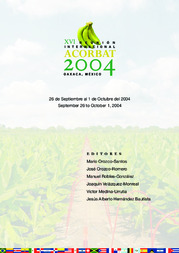Impact and management of Black Sigatoka in Brazil.
Impact and management of Black Sigatoka in Brazil.
Autoria: CORDEIRO, Z. J. M.; MATOS, A. P. de; ALENCAR, S. de O.; GASPAROTTO, L.; CAVALCANTE, M. de J. B.
Resumo: The black Sigatoka disease of the banana crop, caused by Mycosphaerella fijiensis Morelet, anamorph Paracercospora fijiensis (Morelet) Deighton, was first reported in Brazil in 1998, in the State of Amazonas. Currently that disease is widespread all over the North Region of Brazil (except in the State of Tocantins), as well as in the states of Mato Grosso (Center West Region) and São Paulo (South East Region). The presence of black Sigatoka in Brazil resulted in serious problems to the commercialization of fruit and plants of the Musaceae botanical family, due to restrictions to movement of those products from affected regions to areas still free of the pathogen, aiming at preventing its spread. In areas where the disease is already present yield losses may be as high as 100%. Such a situation requested the replacement of the banana varieties under cultivation by black Sigatoka resistant varieties. On this regard, the State of Amazonas played a very important role replacing the susceptible cultivars for Caipira, Thap Maeo, FHIA-18 e Pacovan Ken, all of them resistant to the pathogen. Data on spore survival under several conditions, epidemiological studies, chemical and cultural control strategies of the disease, and genetic resistance, were also generated by researchers. All this knowledge made possible to recommend six black Sigatoka resistant varieties. The recent detection of black Sigatoka in banana growing areas of the State of São Paulo will probably determine a new phase on its banana industry, since it is the State number one on banana production and consumption, as well as the main importer from other banana growing areas of Brazil.
Ano de publicação: 2004
Tipo de publicação: Artigo em anais e proceedings
Unidade: Embrapa Amazônia Ocidental
Palavras-chave: Banana, Doença de Planta, Mycosphaerella Fijiensis, Sigatoka, Sigatoka-negra
Observações
1 - Por padrão são exibidas publicações dos últimos 20 anos. Para encontrar publicações mais antigas, configure o filtro ano de publicação, colocando o ano a partir do qual você deseja encontrar publicações. O filtro está na coluna da esquerda na busca acima.
2 - Para ler algumas publicações da Embrapa (apenas as que estão em formato ePub), é necessário ter, no celular ou computador, um desses softwares gratuitos. Sistemas Android: Google Play Livros; IOS: iBooks; Windows e Linux: software Calibre.
Acesse outras publicações
Acesse a Base de Dados da Pesquisa Agropecuária (BDPA) para consultar o acervo completo das bibliotecas da Embrapa.

